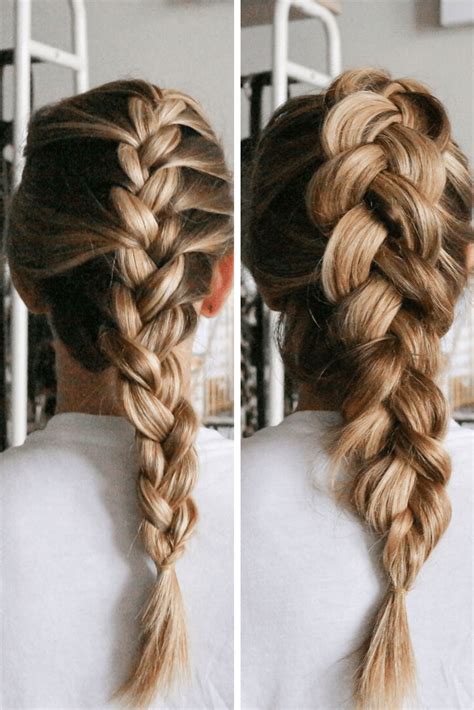Introduction
The world of hair braiding offers a myriad of enchanting options, each possessing its unique allure. Among the most popular and captivating styles are Dutch braids and French braids, both renowned for their intricate grace and timeless elegance. In this comprehensive article, we embark on a captivating journey to delve into the depths of these braiding techniques, uncovering their intricacies, advantages, and distinctions.

Historical Origins
Dutch Braids: A Legacy of Maritime Heritage
Dutch braids, also known as “underhand braids,” trace their roots to the 15th and 16th centuries, when Dutch sailors braved treacherous seas and sought practical yet stylish ways to keep their hair out of the way. The technique involves crossing strands of hair under each other, creating a distinctive “upside-down” or “inside-out” effect.
French Braids: Parisian Refinement
In contrast, French braids, also referred to as “overhand braids,” emerged in 19th-century France, showcasing a more intricate and opulent style. This technique entails crossing strands of hair over each other, resulting in a raised, elegant braid that exudes sophistication and feminine charm.
Step-by-Step Guide
Dutch Braids
- Section off hair: Divide your hair into three equal sections at the nape of your neck.
- Cross sections: Start with the right section and cross it under the middle section.
- Add hair: Grab a small section of hair from the right side and add it to the new right section.
- Cross and repeat: Cross the new right section under the middle section and continue adding hair from the right side.
- Repeat on other side: Repeat steps 2-4 with the left section, adding hair from the left side.
- Continue braiding: Alternate between crossing the right and left sections under the middle section until you reach the end of your hair.
- Secure: Tie off the end of the braid with a hair elastic.
French Braids
- Section off hair: Separate the top section of your hair at the crown of your head.
- Divide into three sections: Subdivide the top section into three equal parts.
- Cross sections: Start with the right section and cross it over the middle section.
- Add hair: Grab a small section of hair from the right side and add it to the new right section.
- Cross and repeat: Cross the new right section over the middle section and continue adding hair from the right side.
- Repeat on other side: Repeat steps 3-5 with the left section, adding hair from the left side.
- Incorporate lower hair: As you braid down the back of your head, gradually incorporate sections of hair from the sides.
- Continue braiding: Continue alternating between crossing the right and left sections over the middle section until you reach the end of your hair.
- Secure: Tie off the end of the braid with a hair elastic.
Variations and Innovations
Dutch Braids:
- Inside-Out Dutch Braid: A playful variation that creates the illusion of a Dutch braid on the surface while the actual braiding occurs underneath.
- Reverse Dutch Braid: This unique technique involves crossing strands of hair over each other, resulting in a braid that is the opposite of a traditional Dutch braid.
French Braids:
- Inside-Out French Braid: Similar to the Inside-Out Dutch Braid, this variation creates a French braid that appears inverted.
- Halo Braid: A captivating style that involves creating a French braid around the head, resembling a halo or crown.
Applications and Social Impact
Dutch Braids:
- Sports and Activities: Ideal for athletes and individuals engaged in physical activities, as they keep hair securely in place and prevent tangles.
- Fashion and Style: Dutch braids add a touch of edgy and bohemian style to any outfit, making them a popular choice for festivals, concerts, and casual outings.
French Braids:
- Formal Occasions: French braids exude elegance and sophistication, making them suitable for special events, weddings, and formal gatherings.
- Romantic and Bohemian: Loose, flowing French braids create a romantic and bohemian aesthetic, perfect for casual dates, beach days, and artistic expressions.
Comparative Table of Features
| Feature | Dutch Braids | French Braids |
|---|---|---|
| Technique | Strands crossed under each other | Strands crossed over each other |
| Appearance | Upside-down or inside-out | Raised and elegant |
| Difficulty | Easier to master | Can be more challenging for beginners |
| Versatility | Suitable for both casual and formal occasions | Ideal for formal and romantic styles |
| Popularity | Popular for sports and activities | Popular for special events and weddings |
Tips and Tricks
Dutch Braids:
- Keep sections taut for a secure and defined braid.
- Add a touch of hairspray to hold it in place for longer.
- Experiment with different thicknesses and angles for unique variations.
French Braids:
- Start with a smooth and frizz-free base for a flawless braid.
- Use a rattail comb to gather and guide the hair sections.
- Practice regularly to improve technique and create more elaborate styles.
Common Mistakes to Avoid
Dutch Braids:
- Crossing strands over instead of under can result in a French braid.
- Pulling sections too tightly can cause breakage and strain.
- Not adding enough hair from the sides can make the braid appear thin.
French Braids:
- Crossing strands under instead of over can create a Dutch braid.
- Not incorporating enough lower hair can result in a short and incomplete braid.
- Over-tightening sections can lead to pain and scalp irritation.
Conclusion
The captivating world of hair braiding offers an endless array of possibilities, with Dutch braids and French braids occupying prominent positions as timeless and versatile styles. Whether seeking a practical and secure option for sports or a touch of elegance for special occasions, both techniques offer their unique charm and allure. Through careful practice and a touch of creativity, anyone can master these techniques and create stunning braids that enhance their beauty and style.
